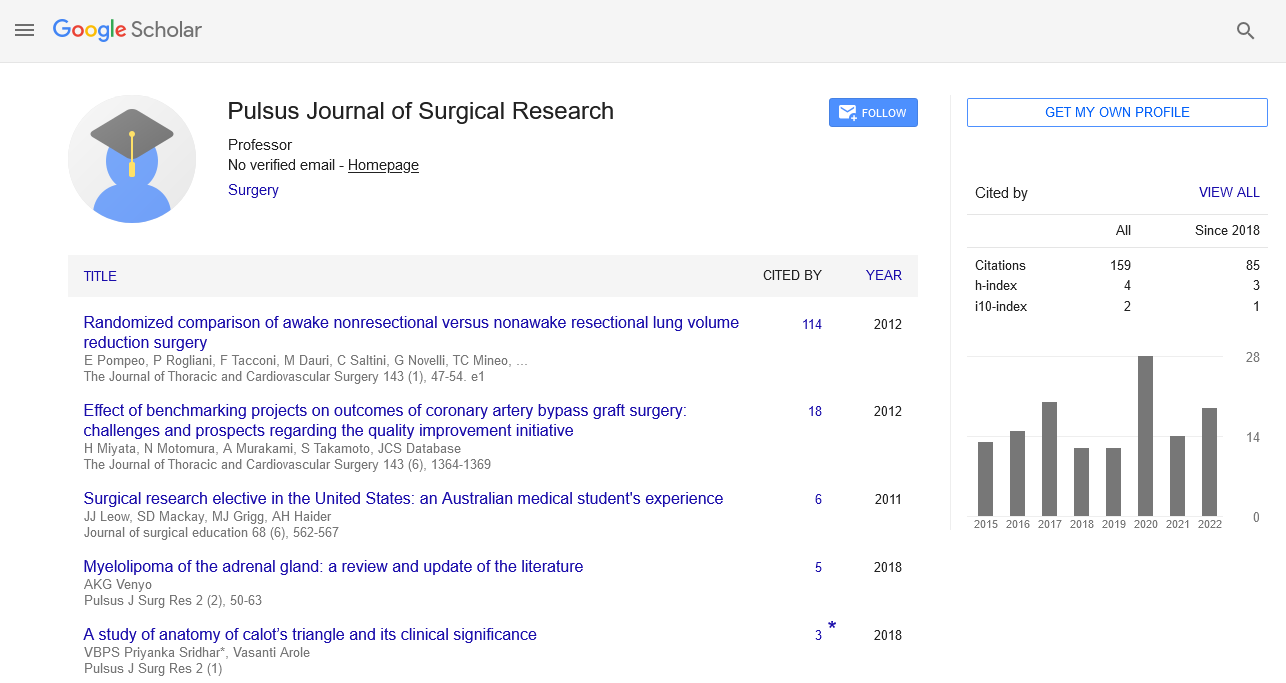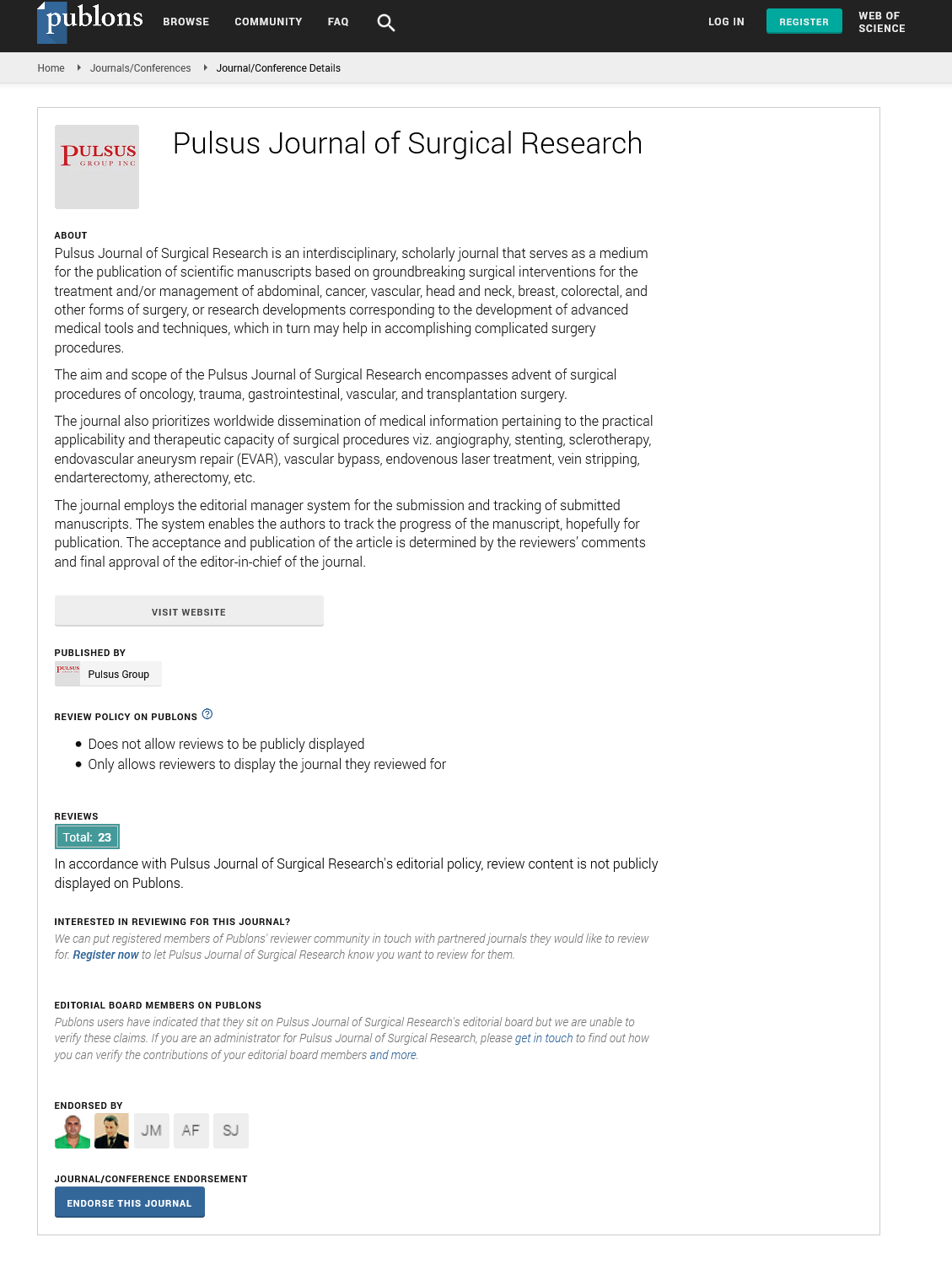Surgery for tuberculous spondylodiscitis with neurodeficit
Received: 03-Aug-2022, Manuscript No. pulpjsr- 22-5749; Editor assigned: 06-Aug-2022, Pre QC No. pulpjsr- 22-5749 (PQ); Accepted Date: Aug 26, 2022; Reviewed: 18-Aug-2022 QC No. pulpjsr- 22-5749 (Q); Revised: 24-Aug-2022, Manuscript No. pulpjsr- 22-5749 (R); Published: 30-Aug-2022
Citation: Kim J. Surgery for tuberculous spondylodiscitis with neurodeficit.J surg Res. 2022; 6(4):58-60.
This open-access article is distributed under the terms of the Creative Commons Attribution Non-Commercial License (CC BY-NC) (http://creativecommons.org/licenses/by-nc/4.0/), which permits reuse, distribution and reproduction of the article, provided that the original work is properly cited and the reuse is restricted to noncommercial purposes. For commercial reuse, contact reprints@pulsus.com
Abstract
Neurological involvement, spinal instability, kyphosis, and a lack of improvement after receiving conservative treatment are the only ones who will have surgery. Complications with the nervous system can happen to anyone. Debridement, repair of segmental instability, neural decompression, and correction of the kyphotic deformity make up the surgical procedure. A good decompression can be achieved by directly accessing the affected tissue, making theanterior approach the most often utilized surgical technique for the anterior and middle columns of the spine. The posterior method, which enables circumferential decompression and three-column fixation, is more advantageous because anterior surgery is linked with a significant risk of structural damage (such as harm to the lungs, liver, heart, kidneys, intestine, and ureter) and graft failure.
Key Words
Virtual Reality; Oral surgery; Anxiety, Surgical care; Neurological.
Introduction
The most crippling type of extra pulmonary tuberculosis is spinal T tuberculosis. Thoracic and thoracolumbar areas of the spine are frequently affected. It is primarily a medical issue, and ant tubercular medication therapy continues to be the cornerstone of care. Only individuals with cold abscess, neurological involvement, spinal instability, kyphosis, and/or failure of conservative treatment are candidates for surgery. The frequency of neurological issues ranges from Debridement, segmental instability repair, neural decompression, and kyphotic deformity correction comprise the surgical approach. The anterior approach has been the most often utilized surgical technique for the anterior and middle column of the spine because it enables direct access to the affected tissue and offers a good decompression. However, there is a considerable danger of structural damage following anterior surgery. The posterior method, which enables circumferential decompression and three-column fixation, has more advantages because to graft failure and its restricted application in mechanical instability and deformity treatment. In patients with neuro impairment who have tuberculous spondylodiscitis, our study seeks to assess the functional, neurological, and radiological results of posterior transfacetal decompression and stabilization. After receiving approval from the institution's ethical committee, patients with Tuberculous Spondylodiscitis who had posterior trans-facetal decompression and stabilization were enrolled in the study. Our study included patients with neuro deficit who had at least a year of follow-up. Histopathology reports and MRI scans were used to make the diagnosis. Based on the drug sensitivity pattern, ant tubercular drug therapy was initiated for all of the patients. Age, gender, length of illness, comorbidities, clinical parameters, neurologic status radiological parameters perioperative variables (operative time, blood loss, hospital stay, Dural leak), postoperative complications (neurology worsening, implant failure), and fusion rate were all assessed. The posterior midline technique was employed in every case when the patient was prone and under general anesthesia. Lamina, facet joints, transverse processes, and spinous processes were all visible. Pedicle screws were manually installed above and below the problematic level. For the purpose of preventing spinal cord injury during debridement and decompression, one side rod was temporarily fastened to pedicle screws. The damaged disc space was exposed through the resection of the inferior facet of the superiorly impacted vertebrae and an adjacent portion of the lamina. Rongeurs and curettes were used to perform the debridement, moving from lateral to medial. To repair the gap, a local bone graft was employed. In any instance, no nerve root was sacrificed. The pedicle was removed and mesh/expandable cages were employed in some instances where the devastation was more severe and anterior column reconstruction was required in those instances along with the facet. If there was a kyphotic deformity, rods were crushed and put on both sides. In each case, the infected material was sent for testing, including tissue for histopathologic analysis, AFB staining, grams stain, fungal smear, polymerase chain reaction/Gene expert test, and culture and sensitivity Patients had involvement in the thoracic and thoracolumbar regions. The patients' average ages were and they had an average follow-up time of. When a single vertebra was affected by the disease lesions, the extent of fixation was segmented in patients, and it was more than segments in patients when two or more vertebrae were affected. According to the drug sensitivity pattern, ant-tubercular therapy was initiated for all patients. A specialist in infectious diseases began treating all patients. The infection was frequently found to be multi-drug resistant, necessitating months of medical therapy. Clinical, radiographic, and blood criteria were used to determine when to discontinue treating all of the patients who had completed their treatment. Patients experienced a transient infection that was treated for weeks with injectable antibiotics. Patients who experienced a dural rip during surgery had it repaired with a face graft. Patients with non-union at years' follow-up exhibited no symptoms of instability and were treated conservatively. Patients with bone fusion showed bony fusion and patients with non-union showed non-union at years' follow-up, of which patients with implant loosening required revision surgery. The majority of spinal motion is in the thoracic region. Typically linked to neurological impairment, paraplegia, and kyphosis. The largest likelihood of morphological abnormalities and likelihood to predispose to deformity advancement is seen in thoracolumbar lesions. a condition where the mainstay of treatment is ant-tubercular medication therapy. Vertebral collapse may continue even though it successfully inactivates. Kyphosis is a common spinal problem that necessitates thorough repair. Last but not least, the Wiederhold et AL study suggested that using VR headsets could reduce fear and anxiety, but the results were not statistically significant. Several techniques for evaluating the primary and secondary judgment criteria because it diverts the mind's attention to vibrant, animated children's worlds, virtual reality has the power to lessen suffering (accompanied by relaxation music for some VR headsets). Since humans have a limited capacity for attention, which is necessary for the perception of pain, diverting our focus helps us to react to pain signals as they emerge more slowly. But these methods frequently resulted in high rates of morbidity and mortality. Thereafter, two-staged anterior and posterior arthrodesis with local bone attaining fusion and a lower risk of pseudoarthrosis were performed. According to certain research, it is possible to treat tuberculous spondylodiscitis with spinal decompression and kyphosis correction by combining anterior debridement with posterior instrumentation. The stability of implants positioned anteriorly in the infected bone was a problem with anteriorly-based surgeries. Recent advances in spinal care include posterior-only surgeries with or without anterior restoration. It is widely known in the literature that the transpedicular technique can be versatile in obtaining appropriate debridement/decompression of the abscess and granulation tissues. In comparison to anterior surgery, posterior instrumentation also has the advantage of achieving better kyphotic deformity correction. It also provides appropriate access to the spinal canal for effective decompression of the neural elements, especially in cases of epidural suppuration, and produces excellent clinical outcomes. Patients with Aug 2022 lumbosacral tuberculosis were treated with transpedicular drainage and posterior instrumentation, a simpler single-stage surgery. patients with the mono-segmental disease and came to the conclusion that a single-stage instrumented posterior debridement with bone grafting offers outstanding clinical results and may not be the best option for treating patients with spinal conditions. In our study, the anterior decompression for thoracic disc herniation was performed using a trans-faceted technique. The method differs from the transpedicular method in a number of ways. First, the disease in trans placental is accessed by resecting the inferior facet of the superior affected vertebrae, and the major involved site is reached using the same foramina pathway. It is a bone-preserving procedure because the pedicle and even the contralateral lamina were left in place, adding to the stability and aiding in fusion. Some of the cases in our study had more severe damage, necessitating the removal of the pedicle in addition to the facet in order to reconstruct the anterior column. Third, a screw that is put into the vertebrae can shorten the build by adding an additional anchor and reducing the length of the construct. We think that stabilizing unstable vertebrae reduces pain and inflammation and that surgery itself lowers infection loads, which together with anti-tubercular drug therapy led to the improvement. Pedicle screws providing three-dimensional correction and stability across the strongest portion of the vertebral body, the pedicle, were substantially more durable than anterior instrumentation. According to our investigation, patients' neurology had improved to some degree. This improvement could be attributed to the fact that our study focused primarily on young patients with acutely deteriorating neurologic symptoms (wet lesions). However, there was a significant reduction in pain and no patient's neurology had worsened at a followup. The outcomes agreed with those of the other investigations. In our study, there was a considerable postoperative correction with a less significant loss of correction at the final follow-up, which also did not result in clinical worsening like in earlier investigations. The majority of the participants in our study had less preoperatively. According to our research, the intact lamina serves as a posterior tether to avoid kyphosis and is a good bed for fusion. Because of this, neither a cage nor a bone transplant is required, especially in cases with single-level spondylodiscitis. The correction of kyphosis was found to be more pronounced in lumbar and lumbosacral examinations than in thoracolumbar tests. A stiff thoracic vertebra with rib attachments may be to blame for this. The average time to achieve fusion in our study was months, which was comparable to the fusion rate in earlier investigations. Once more, our study's fusion rates were comparable to those of earlier research but improved upon them. Infection and fistulas could develop as a result of posterior debridement if it spreads to the posterior healthy zones. Fortunately, none of these issues have been found in our research. In order to achieve complete debridement and decompression, the normal posterior column of the spine had to be destroyed, which theoretically would have affected the stability of the spine. However, we had only removed a portion of the lamina, which ensures the stability of the spine during long-term follow-up. Interactivity and user interaction inside the virtual environment help to establish a sense of presence in the environment, which is one of the fundamental components of an immersive reality experience. Immersive virtual reality combines virtual reality with the extra features of the captured environment to give the user a sense of being in the scene, the ability to visualize the recorded image in, and the ability to interact using a high-tech wearable that tracks hand leaps and detects eye movements. In non-immersive virtual reality, the user interacts with a virtual environment with a mouse while experiencing computergenerated experiences on a desktop. This category includes traditional surgical simulators. Because of improvements in computing power, it is now considerably quicker and more realistic to create simulations.






